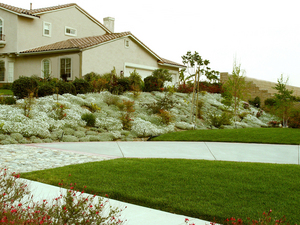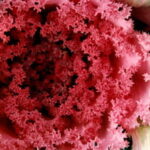A welcoming, lush and green lawn is a big part of the American dream of owning a home, but the challenges of maintaining such a lawn are often harsh realities for even the proudest homeowner. Where traditional plants and turf fail in the landscape, using creeping perennials as lawn substitutes is an alternative that is both ornamental and functional. “Almost every homeowner has an area in the landscape where grass just won’t grow,” says Frances Hopkins, founder and CEO of Under A Foot Plant Company. “Creeping perennials provide the solution for these problem areas.”
Plants with “Sole”
Understanding these problem-solving plants is the first step to a successful lawn replacement project. Creeping perennials should not be likened to common groundcovers, though many homeowners confuse the two. “The difference is definitive,” says Hopkins. “Groundcovers grow much larger at 12 to 24 inches and do not make for a pleasant walking surface. Creepers will grow only about two to four inches creating a pleasant, low visual plane typically associated with a lawn, plus they are sturdy enough to handle foot traffic.”
Most homeowners have at least one problem area in their landscape. Whether a shady spot under a tree that cannot grow grass, a muddy path that sinks in bad weather, a busy garden walkway, a steep bank, around pools, or next to driveways and streets, planting creeping perennials can provide growth where lush foliage and colorful blooms were previously thought impossible. Stepables, Hopkins’ line of more than 140 creeping perennial varieties, provide solutions for such troublesome landscapes.
“Creeping perennials have thousands of tiny, compact root nodes that firmly grasp the soil,” says Hopkins. “As often as you step on them with the soles of your feet, they will vigorously take root; the more they are walked on, the faster they will creep across the landscape space.”
The First “Step” – Plant Selection
First and foremost, homeowners must decide how much they are going to use the planted area. “Foot traffic and function are among the most important considerations when selecting lawn replacement alternatives,” advises Hopkins. This is why she has categorized Stepables into three usage groups – for light, moderate and heavy foot traffic areas.
Light foot traffic is when someone will be walking on the creeping perennials one to two times per week; moderate is one to two times per day, and heavy is three or more times per day. So, when planning the lawn replacement project, it will be helpful to think about how often the plants will experience foot traffic. For example, Hopkins says, traipsing on the plants to take out the garbage would be considered light; getting the mail should be thought of as moderate, and getting in and out of the car several times a day would be heavy foot traffic. When choosing plants, the denser a plant, the more traffic it will take. Therefore, a list of specific areas including expected levels of walking and strolling is a good, initial means to a successful change from grass to this type of planting.
For homeowners looking for an ornamental solution to a small, sloping front yard that will not see much passage, or a planting bed in a quiet corner of a yard, the “light foot traffic” plant options are endless. “However,” Hopkins says, “a homeowner in need of a more functional yard must look at moderate to heavy foot traffic varieties.”
Curb appeal is another important consideration related to improving a home’s landscape and overall appearance. Think about the elements of décor – brick, slate, concrete, paint color, and color schemes,” Hopkins recommends. “Make plant choices that work well with the surroundings.”
With these considerations in mind, the next step is choosing the right plants for the area’s environmental conditions. Hopkins says the number one thing to look for is sun to shade ratio and where the light hits. If the plot of land in question is in sun, consider if it is always full sun or if the exposure is less, such as four hours in the morning or afternoon, or just two hours right at noon. Be certain to read the plant labels for sun and shade specifications when shopping at your local garden center.
Next, homeowners are able to find out their soil quality by taking a sample to a local garden center for analysis. Based on the results, garden center employees can help choose a soil amendment, which ideally should be something with excellent drainage. Correct drainage is described as allowing an appropriate amount of water absorption by the plant’s roots, while also permitting excess water to be drained away from the plant. Of course, determine whether the area has regular water access.
Cold hardiness also varies in different areas of the country. Homeowners can use a helpful zone map and find corresponding plant information at www.stepables.com to choose the best varieties for their particular regions. Independent garden centers generally sell plants that thrive in the regions where they are located, also making plant selection easy.
The Turf Transition
Transition a conventional grass lawn to creeping perennials by using an informed planning process. Choose a proper plant for the area and function, and one that has plenty of availability from the local garden center. Independent retailers tend to offer premium selections. Hopkins developed an online tool to help homeowners easily calculate how many plants they need, which can be tricky. She offers the free device, called the Plant Calculator, on her web site at www.stepables.com. This tool considers the growth rate of various plants, applicable spacing, and the area – in square feet – to be planted. Most of her varieties are available at retail in 3 ½-inch pots, which are a good, accelerated size for rapid growth.
“One of the features of the calculator is fast, medium or slow growth rates per plant, which is something that makes a big impact on the number of necessary plants,” Hopkins says. Spacing the plants 12 inches apart will require fewer of them, but they will take a year or more to fill in and need a bit of maintenance. Spacing plants just two inches apart will require more plants, which costs more. Deciding how dense to plant creeping perennials depends on how much money is in the budget and if instant gratification is a priority.
The next step is removing the sod, and tilling and amending the soil with high-drainage components. A well-prepared bed is necessary to develop a dense, healthy planting. Once the bed is ready, consider placing a slow release fertilizer at root level. Do not place fertilizer directly on the plant because this will burn the foliage,” Hopkins says. Homeowners also can use a liquid feed fertilizer once plants are in place. To avoid hand-weeding, homeowners may opt to apply a groundcloth or preemergent herbicide, though creeping perennials naturally inhibit weeds.
For best results, plant creeping perennials even or just above the soil line, but never below. Planting below the soil line will cause water to collect and, ultimately, drown the plants. Homeowners who wish to topdress plants with mulch, compost or topsoil should first plant varieties just above the soil line, Hopkins advises.
The final “step” is just that – gently step on each plant to set it in place and get it started growing. “Believe it or not, gently stepping on each new plant actually attaches the roots to the soil line. In about three days, little roots will emerge from the nodes,” Hopkins says.
Planning and Planting Tools
Homeowners can help ensure their own success by using the tools available at www.stepables.com to plan projects and plant the right plants. These include the Plant Spacing Calculator and the Topsoil Calculator, the latter helping homeowners determine the amount of topsoil needed to complete the project without incurring waste. In addition, garden centers that carry the plants provide helpful Application Charts, a tool that helps homeowners choose the best plants for their conditions, and how to care for the plants and transition the area to a successful creeping perennial bed.
As with traditional lawns, the more thought, planning, effort and care that homeowners put into installing a bed of creeping perennials, the more it will pay off in the end with the long-term benefit of a beautiful, functional landscape with far less maintenance and more time to simply enjoy it.
Fast Facts about Creeping Perennials
1. Common groundcovers often grow vigorously, sometimes three feet in one year and can require even more maintenance than grass. However, most creeping perennials only reach a maximum height of four inches and are very low-maintenance alternatives.
2. Creeping perennials like Thymus serpyllum ‘Elfin,’ which blooms with gorgeous pink flowers, thrive on steep slopes.
3. Creeping perennials like Stepables root themselves quickly and “creep” naturally, or seem to crawl or tiptoe across the landscape where grass just won’t grow.
4. In heavily worn foot traffic areas, Hopkins recommends laying a gravel base, then planting a variety like Isotoma fluviatillis ‘Blue Star Creeper,’ a hardy, heavy-traffic lawn substitute, in an alternating pattern. “These plants creep in through the rocks, take root, and give a good, firm landscape base,” she says.
5. Ajuga ‘Chocolate Chip’ is a wonderful ornamental lawn replacement that is a dwarf variety and does well in the shade.
6. Sedum ‘John Creech’ is an exceptional variety and, when it goes dormant, it grows runners on top of the ground which offer beautiful texture.
NOTES:
Contacts for all purposes, Don Eberly, 404-574-2900 or doneberly@eberlypr.com or Sally Credille, 404-574-2900 or sallycredille@eberlypr.com.







